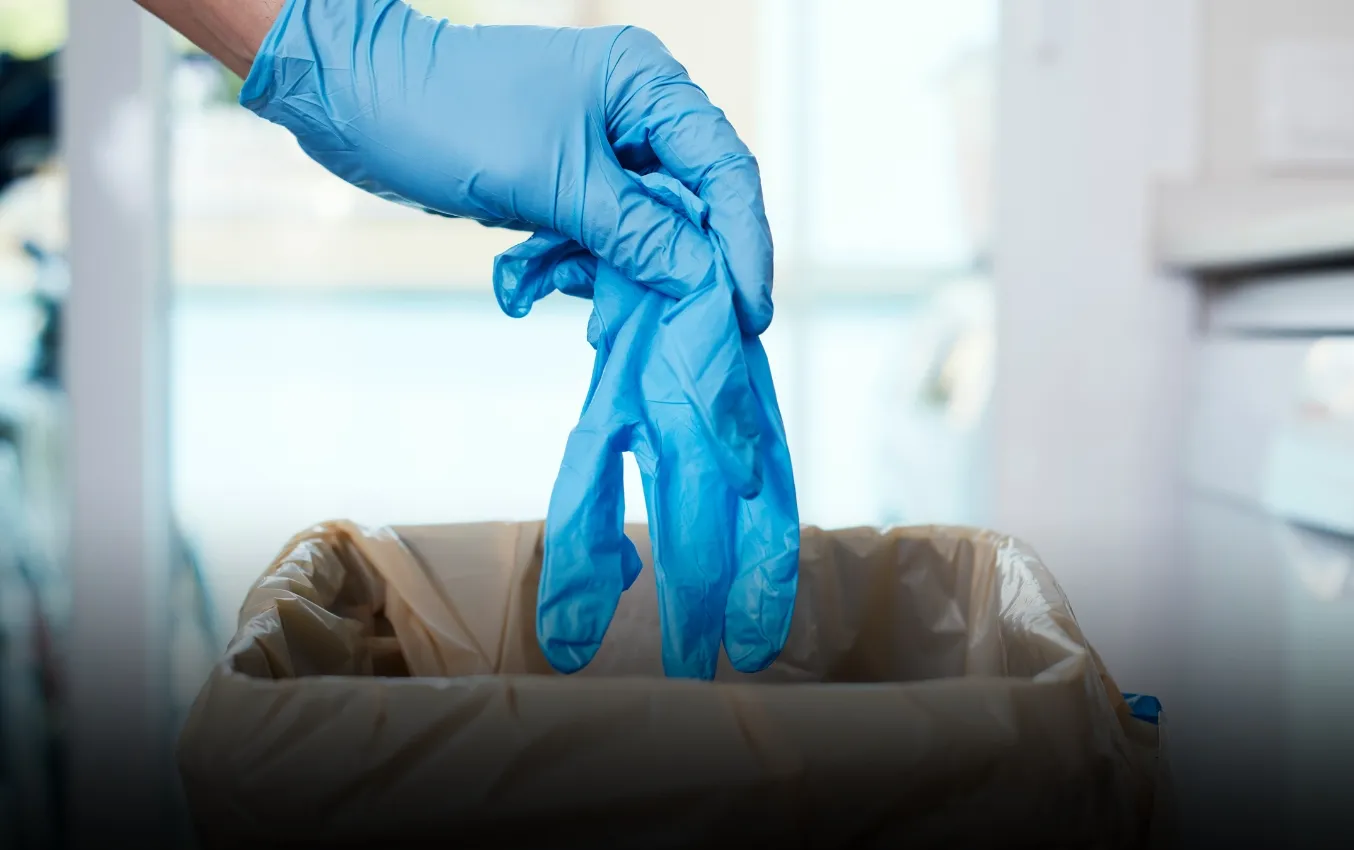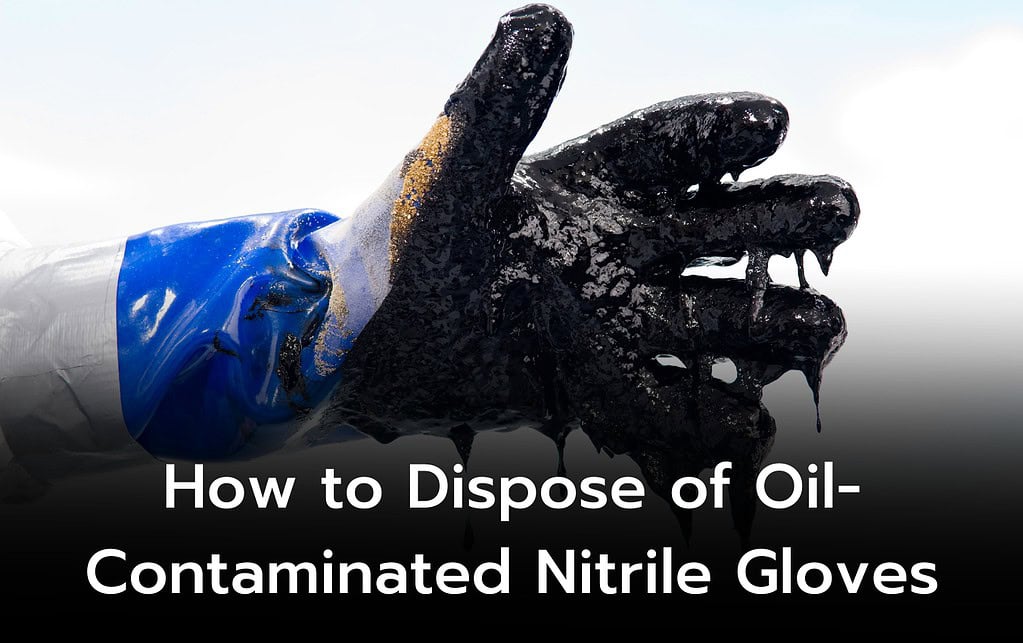As you handle nitrile gloves contaminated with oil, you have a critical role to play in minimizing environmental harm. Improper disposal of these gloves can lead to oil leaks, surface contamination, and even harm to wildlife. However, by following the right steps, you can ensure that these gloves are disposed of in an environmentally responsible manner. In this article, we will guide you through the proper procedures for disposing of oil-contaminated nitrile gloves, helping you to make a positive impact on the environment while maintaining a safe and healthy workspace.
Table of Contents
- Removing Gloves Safely
- Pinching and Peeling
- Containing the Removed Glove
- Containing the Gloves
- Using Plastic Bags
- Preventing Leaks and Contamination
- Disposal Options
- Household Disposal
- Professional Disposal Services
- Recycling Programs
- Avoiding Environmental Harm
- Never Littering
- Preventing Wildlife Harm
- Identifying Waste Type
- Determining Hazardous Waste
- Special Handling Requirements
- Proper Disposal Procedures
- Using Designated Containers
- Sealing and Labeling
- Following Local Regulations
- Transporting to Disposal Facilities
- Record Keeping

Removing Gloves Safely
Your safety is paramount when removing contaminated gloves to prevent further exposure to oil and potential environmental harm.
Pinching and Peeling
Peeling back the layers of protection starts with pinching the glove at the wrist with one hand. Gently peel the glove away from your hand, turning it inside out as you do so. This careful removal technique prevents oil from coming into contact with your skin.
Containing the Removed Glove
Any oil residue on the removed glove can still pose a risk to the environment if not handled properly. Hold the removed glove in the gloved hand, ensuring it remains contained and preventing any potential spills.
Pinching the wrist of the remaining glove, slide your fingers under the cuff and peel it off from the inside, turning it inside out and encasing the first glove inside it. This double-gloving technique allows you to safely contain the contaminated glove, minimizing the risk of oil leakage and environmental contamination.
Containing the Gloves
Any contaminated gloves must be properly contained to prevent oil from leaking out and causing further environmental harm.
Using Plastic Bags
Gloves should be placed in a plastic bag to prevent any oil from escaping and contaminating other surfaces or the environment. Make sure the bag is sturdy and leak-proof to ensure the oil doesn’t seep out during transportation or disposal.
Preventing Leaks and Contamination
Contamination can occur at any stage of the disposal process, so it’s necessary to take precautions to prevent leaks and spills. This includes ensuring the plastic bag or container is securely sealed and handling it carefully to avoid punctures or tears.
Leaks can be particularly problematic, as they can release oil into the environment, causing harm to wildlife and ecosystems. To minimize this risk, you should inspect the plastic bag or container for any signs of damage before transporting it to a disposal facility. If you notice any leaks or weaknesses, transfer the gloves to a new, secure container to prevent further contamination.
Disposal Options
The proper disposal of nitrile gloves contaminated with oil is crucial to minimize environmental impact. You have several options to consider, each with its own benefits and requirements.
Household Disposal
An important step in household disposal is to ensure that the gloves are properly contained to prevent any oil from leaking out. Place the bagged gloves in a trash bin with a plastic liner, making it easier for waste management services to handle.
Professional Disposal Services
For large quantities of contaminated gloves, consider using professional hazardous waste disposal services. These services are equipped to handle and dispose of contaminated materials safely and in compliance with environmental regulations.
Another advantage of professional disposal services is that they have the necessary expertise and equipment to handle hazardous waste, reducing the risk of environmental pollution and ensuring compliance with local regulations.
Recycling Programs
For environmentally conscious individuals, recycling programs offer a responsible way to dispose of contaminated gloves. Check if your local waste management system accepts contaminated gloves for recycling, and follow their guidelines for disposal.
Disposal through recycling programs not only reduces waste but also helps to conserve natural resources and decrease the demand for raw materials. By recycling your contaminated gloves, you are contributing to a more sustainable future.
Avoiding Environmental Harm
Despite the importance of using nitrile gloves for protection, their improper disposal can have devastating environmental consequences. As you take steps to dispose of your oil-contaminated gloves, it’s important to prioritize the well-being of the environment and its inhabitants.
Never Littering
Littering contaminated gloves can lead to the spread of oil and other pollutants, contaminating soil, water, and air. By keeping these gloves out of open spaces and landfills, you prevent the risk of environmental pollution and harm to wildlife.
Preventing Wildlife Harm
Harming wildlife is a significant concern when disposing of contaminated gloves. Oil and other pollutants can be ingested by animals, causing harm or even death. By properly containing and disposing of these gloves, you reduce the risk of wildlife exposure to hazardous substances.
Plus, when oil-contaminated gloves are not disposed of correctly, they can end up in waterways, harming aquatic life and affecting the entire ecosystem. By taking the necessary steps to dispose of these gloves responsibly, you help protect the delicate balance of nature and preserve the beauty of our planet for future generations.
Identifying Waste Type
Many factors contribute to the environmental impact of disposing of nitrile gloves contaminated with oil. To minimize this impact, it’s vital to identify the type of waste you’re dealing with.
Determining Hazardous Waste
Type of waste is critical in determining the disposal method. Since the gloves are contaminated with oil, they likely qualify as hazardous waste. Hazardous waste is any material that poses a threat to human health or the environment, and oil is a common hazardous substance.
Special Handling Requirements
Identifying the type of waste also helps determine special handling requirements. For instance, hazardous waste often requires separate storage, transportation, and disposal procedures to prevent environmental contamination.
For instance, if you’re disposing of large quantities of oil-contaminated gloves, you may need to use specialized containers or transportation services that are designed to handle hazardous materials. Additionally, you may need to follow specific labeling and record-keeping requirements to ensure compliance with environmental regulations.
Proper Disposal Procedures
After ensuring the contaminated gloves are safely removed and contained, it’s necessary to follow proper disposal procedures to minimize environmental impact.
Using Designated Containers
Containers specifically designed for hazardous waste disposal should be used to store the contaminated gloves. These containers are typically marked with a biohazard symbol or other relevant labels, and are designed to prevent leakage and exposure to the environment.
Sealing and Labeling
For secure disposal, seal the container securely to prevent any leakage or exposure to the environment. Make sure the container is leak-proof. With proper sealing and labeling, you can ensure that the container is handled correctly during transportation and processing. A clear label indicating the contents and date of disposal is crucial for proper handling and compliance with environmental regulations.
Following Local Regulations
The key to responsible disposal is adhering to local regulations and guidelines for hazardous waste disposal. Visit your local environmental protection agency’s website or contact them for specific instructions on disposing of oil-contaminated gloves. Disposal regulations vary by region, so it’s necessary to familiarize yourself with local guidelines to ensure compliance. By following local regulations, you can minimize the risk of environmental pollution and harm to wildlife.
Transporting to Disposal Facilities
Disposal facilities equipped to handle hazardous materials should be used to dispose of the contaminated gloves. Arrange for the transport of the hazardous waste container to an authorized disposal facility, ensuring that the facility is certified to handle hazardous materials. Designated facilities have the necessary equipment and expertise to handle hazardous waste safely, reducing the risk of environmental pollution.
Record Keeping
An accurate record of the disposal process is crucial for compliance with environmental regulations. Maintain records of the type of waste, date of disposal, and the facility used. A detailed record of the disposal process helps track compliance with environmental regulations and ensures that you can provide evidence of responsible disposal practices. By keeping accurate records, you can demonstrate your commitment to minimizing environmental impact.
Taking this into account, you now have a clear understanding of how to properly dispose of nitrile gloves contaminated with oil to minimize environmental impact. By following the steps outlined, from removing the gloves safely to considering recycling programs and professional disposal services, you can ensure that you are doing your part to protect the environment. Be mindful of, responsible disposal is crucial to preventing pollution and harm to wildlife, so take the time to do it right.
